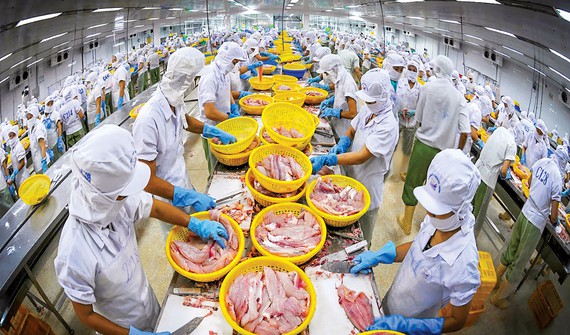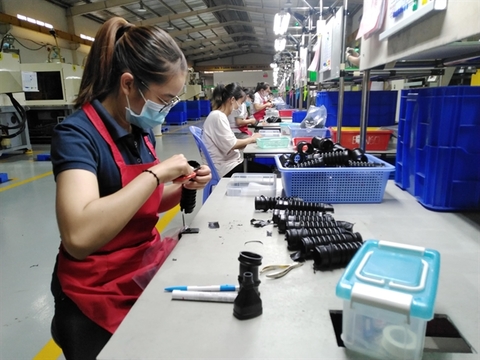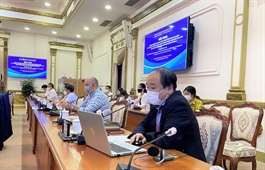Export targets difficult to meet under pandemic
Export targets difficult to meet under pandemic
Several export enterprises have now been compelled to temporarily suspend operations in many provinces and cities in the Southern parts of the country.
Illustrative photo.
|
The widespread impact of the Covid-19 pandemic has called for the implementation of strict measures under Directive 16, which means maintaining social distancing and avoiding crowded places. These measures have unfortunately brought down productivity and exports have been very badly affected and are now expected to see a sharp drop in the last months of the year.
Decline since July
According to data from the General Department of Customs, in July 2021, the total import and export value of Vietnam's goods was estimated at USD 53.5 bn, down 2.5% compared to the previous month. In this, the total export value was estimated at USD 26 bn, down 4.4% and the total import value at USD 27.5 bn, down 0.6%. Many key export items had already begun to show signs of a decline in turnover.
Specifically, for wood and wood products, the export value in July was estimated at USD 1.3 bn, down 16.6% from the previous month. For footwear, export value in July was estimated at USD 1.7 bn, down 11.8% compared to the previous month. Fishery goods were estimated at USD 800 mn in July, down 5.8% compared to the previous month. The fruits and vegetables produce did not see a steady growth in the first six months of the year, and by July the turnover had decreased, reaching only USD 266 mn, a decrease by nearly 17% compared to June.
The cause of this decline was the virulent outbreak of the Covid-19 pandemic in Ho Chi Minh City and all the Southern provinces, especially from 15 July when Ho Chi Minh City and the Southern provinces only allowed production activities with guaranteed enterprises, and requested pandemic prevention measures with a plan to offer workers the option to work and live on site under the “3-on-site” model plan. Many enterprises could not meet these requirements, so they had to stop production. The remaining few who could meet these strict requirements saw a significant decline in productivity. Besides, some of these enterprises who continued operating saw many workers infected despite the extra precautions.
For example, in the seafoods industry, about 30% of enterprises in the Southern provinces could maintain production activities according to the “3-on-site” model, where workers lived and worked in their workplace. These enterprises could only mobilize 30% to 50% of employees, so productivity decreased sharply and costs increased far too high. The textile and garments industry is also in a similar situation where only about 30% of enterprises can meet the requirements of the “3-on-site” model plan, while the rest have had to suspend production. Many businesses also have sort to move orders to the North of the country, to keep up with the delivery schedule, but that number is quite limited.
According to Ms. Phan Thi Thanh Xuan, Vice President and General Secretary of the Vietnam Handbags and Bags Association, businesses in the leather and footwear industry are mainly concentrated in the South, but from mid-July, about 90% of enterprises have had to suspend production because they cannot meet the requirements of the “3-on-site” model plan. A few enterprises in the North are also affected by the congestion of importing raw materials from the South, so productivity has also decreased. This has caused the July export turnover to decrease in the entire industry.
Challenging last months
In the current context of a raging pandemic, the big question arising from now until the end of the year is whether export industries will make efforts to reach the targets as set out or not. The answer largely depends on the pandemic control situation in the provinces and cities, especially in Ho Chi Minh City, Binh Duong, Dong Nai, and Long An provinces, where there are many large export enterprises operating.
However, even in August, the situation is difficult with export turnover showing a sharper decline than in July because the pandemic prevention and control requirements are becoming even much more stricter. According to a general assessment by many businesses, from now until the end of the year, businesses will find it difficult to meet the targets set out at the beginning of the year. Specifically, for the fruit and vegetable exports segment, the turnover has decreased substantially, and may only reach till about USD 3.4 bn, while the target set for this year is USD 4 bn.
Mr. Dang Phuc Nguyen, General Secretary of the Vietnam Fruit and Vegetable Association, said that for a long time, almost 70% of Vietnamese vegetables and fruits have been mainly exported to the Chinese market, but due to the impact of the Covid-19 pandemic, the process of importing goods to China has become much stricter. In the past, the Chinese side used to disinfect each batch, but now they check and disinfect each container. Thus, together with the slow speed of bringing agricultural products into the country, because of too many checkpoints, it is difficult to increase export turnover.
Along with so many continuing difficulties, the cost of logistics has also become a barrier for many export enterprises. For example, enterprises that export fresh fruits to markets as far away as the US, Europe, and Japan, are currently at a stand still due to shortage of empty containers and because of increased freight charges. Lack of containers has slowed down the shipping time, affecting the quality of fresh fruits. High freight rates have caused serious losses to many businesses, because not all import partners are willing to share this burden. High freight rates is not just affecting the fruit industry but is also a general concern of all export companies since mid-2020 until now.
Besides facing worries about meeting export targets for this year, many businesses are also worried that in the near future they will lose orders and customers when orders are moved to other countries with better disease control measures. Once the orders have been moved, it is extremely difficult to get back the same customers again. This will affect the entire export situation next year. To tackle this situation, export enterprises have proposed flexibility in the “3-on-site” model, because it cannot be maintained for more than one month. When the situation is under control, enterprises will have to be more flexible with workers and avoid losing customers.




















